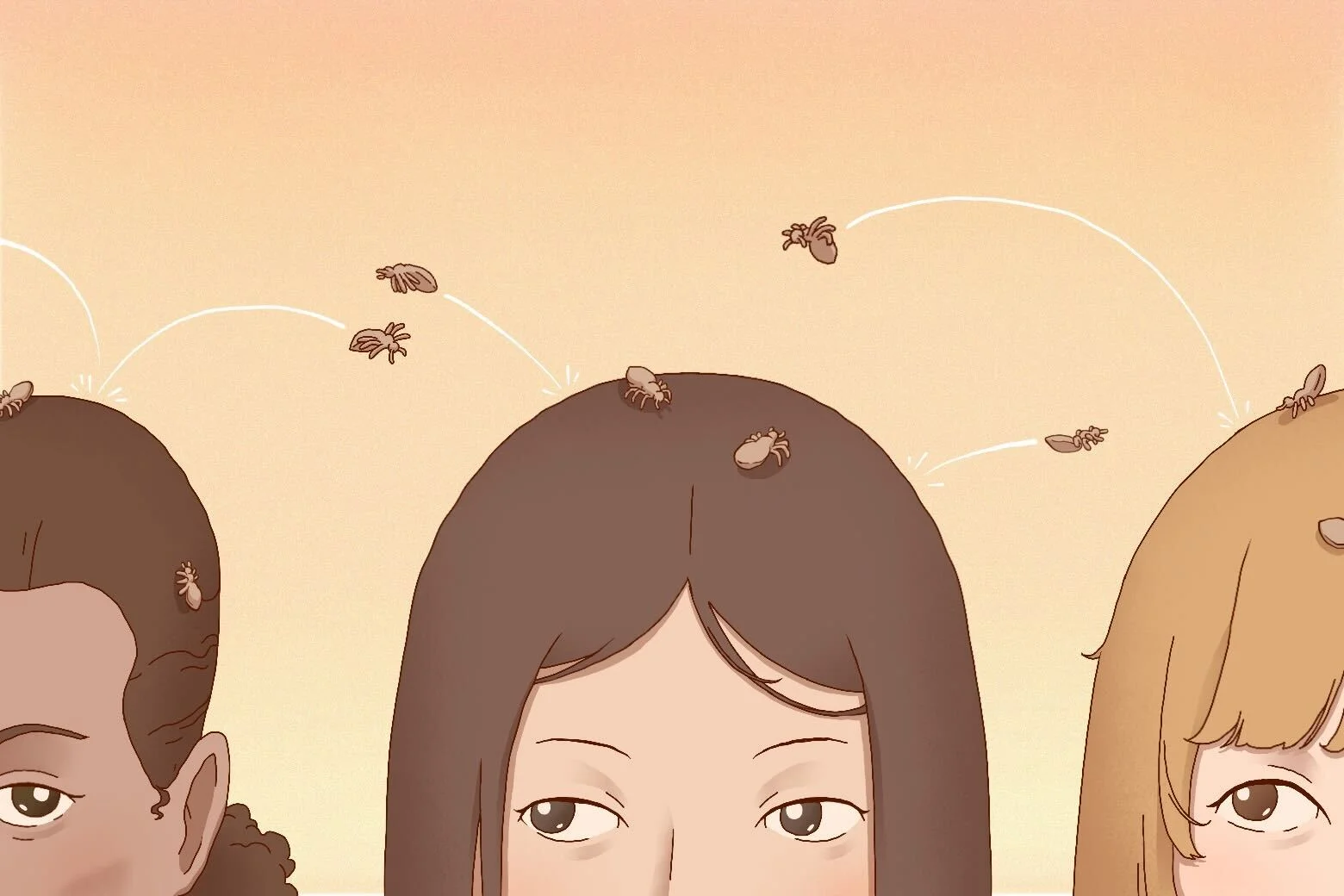Copyright Slate

Sign up for the Slatest to get the most insightful analysis, criticism, and advice out there, delivered to your inbox daily. At 2:07 a.m., after three hours of combing through my hair, I found the culprit behind my itchy scalp. I zoomed in with my phone camera and, swallowing a gag, confirmed what I’d feared: At 25 years old, I had a case of head lice. The children I babysit gave it to me as an anniversary gift this January, a celebration of 20 years since my first encounter with the bugs. I’d dealt with infestations at ages 5, 8, 12, 17, and now 25—so I knew my next steps. But I didn’t know why this kept happening to me. I caught one of my early infections after a slumber party where we girls huddled shoulder to shoulder watching Amanda Bynes confess her love in What A Girl Wants. Later they crawled over while I shared a pillow with my heartbroken high school best friend. We cursed her ex-boyfriend, and the lice wanted to help. In college, I narrowly escaped the infestation that ravaged my freshman dorm. Our floor spent countless nights piling onto twin beds, sharing snacks and classroom drama, making this new space feel like home. “This is why that thing always happens to you guys,” my friend’s mom once commented on a photo of us lying head-to-head at the beach. And it is! Thinking it over while the lice technician zapped my hair with bug-killing heat, I came to a conclusion: Lice are my ultimate testament to girlhood. Of course, girls aren’t the only ones who get lice. Plenty of people of all genders, especially those with longer hair, come face-to-face (or face-to-head) with the pests. For me though, these bugs have become a symbol of the close-knit communities that have shaped my life as a girl. “Lice were here before us, and they’ll outlive us all,” my mom says every time I break the itchy news to her. And these tiny, resilient, blood-sucking insects will. According to Lice Clinics of America, the species developed 1.68 million years before homo sapiens. Today, the Centers for Disease Control estimates head lice infect 6 to 12 million people per year, traveling from scalp to scalp and laying eggs along the way. And as time goes on, they’ve only evolved to survive lice-killing innovations. “Mother Nature has a better laboratory than we do,” says Harvard entomologist Richard Pollack. “So this is a problem we’re always going to have to deal with.” But over all those years, their means of infection hasn’t changed. Head lice have always traveled exclusively through head-to-head contact—it’s community that keeps them alive. According to the CDC, some studies suggest that young girls are the group most likely to contract the critters. Part of that reasoning comes down to the obvious. The vast, dark, and warm environment of many girls’ long hair makes an ideal home for lice. But there’s also a more sociological explanation. Women and girls are socialized as community builders who connect through physical and emotional intimacy. So, while the bugs inhabit children’s hair more often, Pollack promises me that head lice can be par for the course for an adult with close-knit, caring relationships, “But in addition to emotional support, you run the risk of contracting some viruses,” he says. As he talks, a montage plays: The 2-year-old I nanny wails into my neck after a scooter topple, my head nods off on a pal’s shoulder during our road trip to the Women’s March, and my eight besties squeeze on a bed, reassuring our friend she’s much better than that scumbag from English class. (This whole thing is set to Willie Nelson’s “Seven Year Itch.”) “Women want interdependence and to nurture their friends,” friendship expert Anna Goldfarb says. Studies show women engage in “face to face” friendships, meaning that women often spend time with their girlfriends just connecting, not necessarily doing an activity. Researchers found that women tend to express more physical affection in friendships, and psychologists found their friendships tend to be more “intense, exclusive and emotionally close.” I feel that closeness reflected in my friendships every day. During the uncertainty of the pandemic, watching 23 (yes, 23) seasons of Survivor on the couch with my college roommates offered rare joy and stability. When I grieved a family member while living in Australia, my girlfriends made me food, bought me flowers, and kept me afloat 9,237 miles away from home. Although getting lice tends to be a grimy consequence, often inconvenience is the price we pay to reap the benefits of community. “Frankly, there’s nothing my daughter loves more than having a gang of kids over, mushing up on the bed and watching movies,” says pest-management entomologist Dawn Gouge. “You don’t ever want kids to stop having those lovely memories, you just have to manage the situation.” That said, many of these physicality discrepancies have been studied only on a gender binary and relate to social factors discouraging physical affection among men. Anthropologist Alma Gottlieb notes that caretakers hold girl newborns more tenderly and for longer, and handle boys more vigorously and for less time. “That’s really striking when you’re talking about a creature just out of the womb,” Gottlieb says. Sarah Hedgecock, a Tulane University postdoctoral fellow who studies girlhood, says she was called “strange for a girl” growing up not wanting to hug her friends. When she’s out with her husband, she notices he’ll get a handshake and she’ll get a hug. “Touching is feminized,” she says. While I wouldn’t trade my intimate relationships for a lice-free scalp, “girlhood” also contributes to the gnarly stigma that getting lice carries. For a social group held to the standard of beauty and cleanliness, many girls don’t want association with an allegedly “dirty” infliction. During my fourth bout of lice, as a high schooler in 2015, I went to a party flaunting my brand-new pale-pink tank and freshly flat-ironed hair. I’d spent my ice-cream-scooping money to look this good in the hopes that my crush would pop the question: “Do you want to hang out?” I felt so cute all night, and then I felt … an itch. I panicked. Not out of fear of bugs potentially crawling around my scalp, but more that my crush would never talk to me again if that tickle turned out to be those all-too-familiar guests. I wish that 16-year-old boy could have known the truth: Having lice doesn’t mean I’m dirty. “Human lice don’t care how often the hair is cleaned, washed, combed, or brushed,” Pollack says. “I’ve seen them as often on hair that has never been attended to as on hair that gets shampooed multiple times a day.” What really matters to lice is that you have hair, Pollack says. And, according to Gauge, the shape of that hair makes a difference. A “round hair shaft”—flat, straight, or thin hair—hosts lice more easily. Lice struggle to grip an “elliptical hair shaft”—tightly coiled, curly hair. However, if elliptical hair is tightly braided next to the head, then lice can thrive, she says. “All they need is that ability to cling on close to the scalp.” For all the joy that having lice represents to me, I still want to get rid of the buggers. If you find a critter, first confirm that it’s a louse, not a garden insect, Pollack says. Then, you can treat it yourself with a fine-toothed lice comb and approved gel, or hire a professional. Some companies use heat treatments and some use manual removal to de-critter hair. As someone who’s tried every removal method, is it wild to say I even treasure the community-building memories within the delousing process? My best friend and I would jump on her backyard trampoline with olive oil–soaked hair, thrilled to skip school while our moms (less thrilled) poured wine and waited for the “lice detectives” to arrive. We laughed, flipped, and selfied, feeling connected by being partners-in-bug. Yes, bugs in your hair are gross. But so is sitting on the ground of a bar with your college friends, spit pacts with summer-camp bunkmates, and weekends of pizza-filled Twilight binges with your roommates. That’s girlhood—messy, close, unfiltered, and worth every inconvenience.



